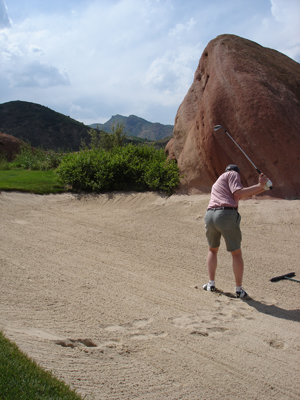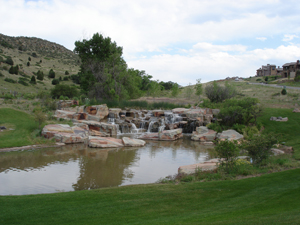
Photo by Reid G
Vail golf still good despite short growing season
June 23, 2008 —
As we transition into the summer months in the Vail Valley I can’t help asking myself “did we have a spring?” If you ask any of the Valley’s golf course superintendents they will tell you that the growing period for turf on the golf courses as well as your own lawn is at least a month behind schedule.
I guess that’s what we get for skiing 20 inches of powder on the final days of the official ski season. I for one missed spring this season, usually a chance to head west where the warm weather is abundant and golf is cheap, a time to give my feet a rest from the grapple of my packed out ski boots. Alas, beggars can’t be choosers and as we all know, that’s the price we pay for living in the Rocky Mountains.
Golf season is in full swing now, and pun aside, every golf course in the Valley is reaping the benefits of the almost record snowfall from the winter. Flooding has occurred at Eagle Ranch as well as the Vail Golf Club from swelling runoff of Abrams Creek and Gore Creek, but has not stopped hackers and slicers from strapping on the spikes and chasing “whitey” around the yard.
Green grass and tight lies exist on all the fine courses our valley has to offer, even the Cordillera Summit Course which was buried under nearly 20 feet of snow opened for play June 12. I have played my share of rounds so far, although not as much as I would like, limited by the birth of my first.
I did have the chance to join Realvail.com editor Tom Boyd for a jaunt to southwest Denver where he was writing a golf article about a new club called Ravenna. Although not entirely related to our “Happy Valley” I was so impressed by the experience I thought I would share.
This private, no cash club opened June of 2007 with bagpipes and champagne. It is a Jay Morrish design, with members including Colorado favorites like Colorado Avalanche Joe Sakic and Colorado’s first family of golf, the Stadlers.

Tom and I played with founder Glenn Jacks and Director of Golf Seth Berliner, who gave us the total golf tour. Glenn Jacks comes from a finance and real estate back round from Colorado to Florida to California. As a landscape architect Mr. Jacks has also been involved in designing notable clubs like PGA National in Palm Springs as well as TPC Sawgrass in Ponte Vedra, Florida. Seth Berliner is a class-A PGA professional, former minor league ball player and native Coloradan started his career at the prestigious Cherry Hills C.C. and was nice enough to play with us regardless of his very pregnant wife; due June 25. Congrats Seth!
Mr. Jacks’ dream course, set under the staggering red rocks near the Chatfield State Park takes each and every hole and makes them pieces of art. From the angles of the five sets of tee boxes, to the native landscaping and bunker placement. Each hole allows the golfer to use his imagination on and around the green surface, making it a wonderful test of golf for the low handicapper and a fun visual experience for the beginner. This par 71 course spans over 7,200 yards from the back tees with a slope rating of 149, and a friendly and forgiving slope of 129 from the forward tees, with the max yardage of just over 5,000 yards. We played the Forest, or “Member” tees, which most members play on a regular basis and although only 6,500 yards, which in this day and age may seem a bit short, the design from the first hole and on screams “hit the ball in the short stuff.” And from what I saw on the practice tee, Tom was about to have the time of his life.
Par 35 on the front side with two par fives and three par 3’s allows golfers the chance to score well, if arrant shots can be avoided. Did I mention the Seventh hole, a reachable par 4 with an undulating green. The longer hitters must go for it while the weary can lay up with a hybrid and have only a wedge in. A challenging par 3 ninth leads golfers into the back nine where the fairways open up a bit more, but the views and landscape stay the same. Both par fives on the back nine cover more that 600 yards from the tips, with number 14 creeping down hill with a peaceful myriad of waterfalls leading the way.
Talking with Glenn Jacks, I got the sense that he has been on his share of courses through his career and has seen the designs that work and those that don’t. With his vision for Ravenna, Mr. Jacks wanted to do everything he could to limit the environmental impact from the golf course, including building a water treatment plant on site to recycle and clean both natural water and irrigated water. And if that’s not green enough, Ravenna spent millions proactively working with the Division of Wildlife to ensure that every acre of golf property was deemed a wildlife sanctuary, which it is. Mr. Jacks wanted the future of the golf course to look like it was part of the original landscape, untouched, as if 1.5 million cubic feet of soil was not moved, a course that has the look as if the course had been there for hundreds of years prior.
Reaching the 16th hole, a mid yardage downhill par 3, considered their signature hole by members, it’s the only hole on the golf course that requires golfers to adjust more than a one club difference. Something by first glance should be the norm on six or seven holes total, another Jacks/Morrish visual masterpiece.
If you ask the staff members at Ravenna, they consider all eighteen holes signature golf holes, and after making a four on the final hole of a fabulous golf day, I couldn’t agree more. If you ever get a chance to play Ravenna golf club I highly recommend jumping at the opportunity. A visually intriguing and stunning golf experience for every golfer. For more information on Ravenna visit www.ravennagolf.com and also keep watch for Tom Boyd’s article in Rocky Mountain Golf Magazine.
![]() 1 Comment on "Vail golf still good despite short growing season"
1 Comment on "Vail golf still good despite short growing season"
Reid — July 2, 2008
Does this rock make my ass look bigger? Why couldn't I have been this fat in high school?












